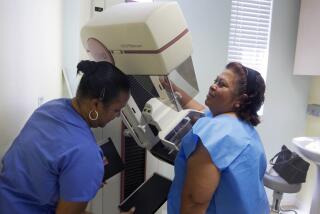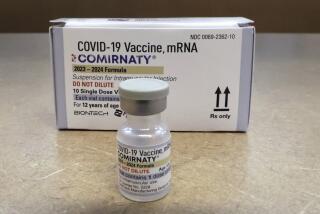U.S. needs twice as much lung cancer screening for current and former smokers, panel says

- Share via
More Americans now qualify for yearly scans to detect lung cancer, according to guidelines released Tuesday that may help more Black smokers and women get screened.
Lung cancer is the nation’s top cancer killer, causing more than 135,000 deaths each year. Smoking is the chief cause, and quitting is the best protection.
Usually, lung cancer is diagnosed too late to give patients a good chance at survival. But some Americans who are at especially high risk for the disease get an annual low-dose CT scan to improve those odds by detecting signs of cancer earlier.
Who’s eligible? Anyone between the ages of 50 and 80 who has smoked at least 20 “pack-years” and either still smokes or quit within the last 15 years, according to the new advice from the U.S. Preventive Services Task Force. A “pack-year” is an amount equivalent to smoking a pack of cigarettes a day for a year. So someone could qualify by going through a pack a day for 20 years, or two packs a day for 10 years.
California has the third-lowest rate of new lung cancer cases in the country. But nearly a quarter of patients diagnosed with the disease receive no treatment.
Since 2013, the CT scans have been recommended for heavier smokers — those who smoked at least 30 pack-years — and those a little older, starting at age 55. The task force updated the guidelines Tuesday after newer research showed lighter, younger smokers benefit, too.
About 15 million people are estimated to meet the new criteria — nearly double the prior number.
The new recommendation was published in the Journal of the American Medical Assn.
The task force recommendation means health insurers must offer the screening without a copay to people who meet the criteria.
The changes “mean more Black people and women are now eligible for lung cancer screening, which is a step in the right direction,” Dr. John B. Wong, a task force member at Tufts Medical Center, said in a statement.
The panel said African Americans and women tend to be less heavy smokers and may not have met the earlier screening threshold despite being at risk for lung cancer.
Cancer specialists welcomed the changes in an editorial published in JAMA Surgery.
But “unfortunately, lowering the age and pack-year requirements alone does not guarantee increased equity in lung cancer screening,” wrote Dr. Yolonda Colson and colleagues at Massachusetts General Hospital.
Her team noted “formidable” barriers, including poor access to healthcare and even doctors not familiar enough with the screening to identify good candidates and help them decide whether to get the test.
One recent study found just 14% of people eligible for lung cancer screening under the prior guidelines had actually gotten it. In contrast, 60% to 80% of people eligible for breast, colon or cervical cancer screening get checked.
People offered lung cancer screenings also must consider the risks of invasive testing to tell if any abnormality spotted by the scan really is a tumor. Lung biopsies occasionally cause serious, even fatal, complications.






